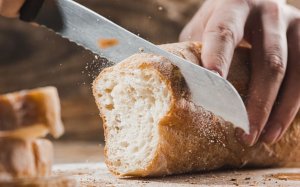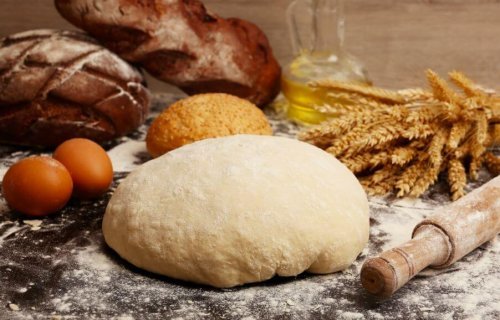Characteristics and Benefits of Bread

Bread is a staple food composed mainly of flour, water, yeast, and salt. This food has multiple benefits for our health thanks to its abundance of carbohydrates, proteins, fiber, and vitamin B. It also barely contains any fat.
Nowadays, there are many varieties and each one has several nutritional characteristics. Additionally, people with celiac disease or gluten intolerance—which is a protein found in wheat grains and other whole grains—can substitute common bread for cornbread, which doesn’t contain gluten.
What ingredients does bread have?
– Flour: we obtain it after grinding the grain of wheat and it’s the most important ingredient in bread. Moreover, it’s also responsible for giving bread its structure. It can also be made up of different kinds of grains, such as corn, barley, or rye. Although the most common one is wheat flour.

– Water: the dough is made with water. In addition to water, we can include other liquids to obtain different flavors, such as milk, fruit juices, or beer.
– Yeast: it’s another fundamental ingredient since it’s necessary to ferment the dough and to make the bread lighter. Yeast also gives bread its characteristic sponginess by causing fermentation. Even so, there are several types of bread that don’t use yeast, they’re called unleavened bread.
Besides all of the ingredients that we have listed, others are often added that improve the fermentation process. Sugar, for instance, can improve the flavor. Other components we can include are fats, sunflower or sesame seeds, fruits, or eggs.
Types and benefits
We must know what kind of bread we are consuming because not all types of bread are the same. Up next, we’ll show you different types and the characteristics of each.
White
Surely, it is the most well-known bread around the world and also the most consumed. We can find it as a loaf, rustic, or artisanal and in different ways. It’s a healthy and very nutritious bread since it’s made with wheat flour, which makes it great for everyone. With it, you can help regain your strength and calm your hunger. This is especially beneficial for athletes, as long as the bread is artisan made and not pre-cooked.
Whole Wheat
This bread is made with whole wheat flours that provide our bodies with many more vitamins, minerals, and fibers than other types of bread, such as white bread. This is because the flour is produced from the whole grain of wheat.

They emphasize the vitamins of group B, which benefit the nervous system. Minerals such as calcium, phosphorus, potassium, and magnesium are also important for the nervous system.
With this type of bread, you can prevent cancer, improve constipation, and lower your cholesterol, as fiber helps lower blood levels. It’s also advisable for diabetic people because it maintains blood sugar levels. However, it’s not recommended for people with alterations in the intestinal tract.
Bran
You have to know how to differentiate it from whole wheat bread. This type is made with refined flour to which they add fragments of bran, so it’s still white bread. The difference is that it has greater fiber intake, but with the same amount of nutrients.
The benefits it provides to our bodies is most favorable for people who suffer from constipation and those who don’t like to the taste of whole wheat bread.
Unleavened
We can make it with the same ingredients as the others but without yeast. Thanks to this, we obtain a much more compact mass and its digestion is slower. Thus, it contributes to high levels of satiety to our body, which is recommendable for people who are on a diet. Some examples of this bread are chapati, corn tortillas, or pita, which generates very heavy digestions.
Without salt
Ideal for people who are hypertensive. Given its characteristics, they can continue consuming bread without having to exclude it from their diet.
In conclusion, there are all these types of bread and others that we haven’t mentioned, such as rye, corn, spelt, toast, or with nuts. All of them are distinct and offer different benefits to our body, so don’t hesitate to try them.
Bread is a staple food composed mainly of flour, water, yeast, and salt. This food has multiple benefits for our health thanks to its abundance of carbohydrates, proteins, fiber, and vitamin B. It also barely contains any fat.
Nowadays, there are many varieties and each one has several nutritional characteristics. Additionally, people with celiac disease or gluten intolerance—which is a protein found in wheat grains and other whole grains—can substitute common bread for cornbread, which doesn’t contain gluten.
What ingredients does bread have?
– Flour: we obtain it after grinding the grain of wheat and it’s the most important ingredient in bread. Moreover, it’s also responsible for giving bread its structure. It can also be made up of different kinds of grains, such as corn, barley, or rye. Although the most common one is wheat flour.

– Water: the dough is made with water. In addition to water, we can include other liquids to obtain different flavors, such as milk, fruit juices, or beer.
– Yeast: it’s another fundamental ingredient since it’s necessary to ferment the dough and to make the bread lighter. Yeast also gives bread its characteristic sponginess by causing fermentation. Even so, there are several types of bread that don’t use yeast, they’re called unleavened bread.
Besides all of the ingredients that we have listed, others are often added that improve the fermentation process. Sugar, for instance, can improve the flavor. Other components we can include are fats, sunflower or sesame seeds, fruits, or eggs.
Types and benefits
We must know what kind of bread we are consuming because not all types of bread are the same. Up next, we’ll show you different types and the characteristics of each.
White
Surely, it is the most well-known bread around the world and also the most consumed. We can find it as a loaf, rustic, or artisanal and in different ways. It’s a healthy and very nutritious bread since it’s made with wheat flour, which makes it great for everyone. With it, you can help regain your strength and calm your hunger. This is especially beneficial for athletes, as long as the bread is artisan made and not pre-cooked.
Whole Wheat
This bread is made with whole wheat flours that provide our bodies with many more vitamins, minerals, and fibers than other types of bread, such as white bread. This is because the flour is produced from the whole grain of wheat.

They emphasize the vitamins of group B, which benefit the nervous system. Minerals such as calcium, phosphorus, potassium, and magnesium are also important for the nervous system.
With this type of bread, you can prevent cancer, improve constipation, and lower your cholesterol, as fiber helps lower blood levels. It’s also advisable for diabetic people because it maintains blood sugar levels. However, it’s not recommended for people with alterations in the intestinal tract.
Bran
You have to know how to differentiate it from whole wheat bread. This type is made with refined flour to which they add fragments of bran, so it’s still white bread. The difference is that it has greater fiber intake, but with the same amount of nutrients.
The benefits it provides to our bodies is most favorable for people who suffer from constipation and those who don’t like to the taste of whole wheat bread.
Unleavened
We can make it with the same ingredients as the others but without yeast. Thanks to this, we obtain a much more compact mass and its digestion is slower. Thus, it contributes to high levels of satiety to our body, which is recommendable for people who are on a diet. Some examples of this bread are chapati, corn tortillas, or pita, which generates very heavy digestions.
Without salt
Ideal for people who are hypertensive. Given its characteristics, they can continue consuming bread without having to exclude it from their diet.
In conclusion, there are all these types of bread and others that we haven’t mentioned, such as rye, corn, spelt, toast, or with nuts. All of them are distinct and offer different benefits to our body, so don’t hesitate to try them.
All cited sources were thoroughly reviewed by our team to ensure their quality, reliability, currency, and validity. The bibliography of this article was considered reliable and of academic or scientific accuracy.
- Aguirre Arias, W. L. (2011). Determinación de los tiempos de fermentación de la masa de pan utilizando diferentes porcentajes de levadura fresca (saccharomyces cereviseae) en la panificadora américa [Tesis de pregrado, Universidad Técnica del Norte]. Recuperado de http://repositorio.utn.edu.ec/handle/123456789/463
- Chungata, R., & Rodrigo, L. (2013). Determinación de fibra en pan integral procedente de panaderías artesanales. Universidad del Azuay.
- Ribotta, P. D., Tadini, C. C., de Alcântara Pessoa Filho, P., Gularte, M. A., Collar, C., Galotto, M. J., Gómez Pallarés, M., Guarda, A., Guzmán, R., Lappe–Oliveras, P., León, A. E., Rosell, C. M., Moreno Terrazas, R., Oliete, B., Pedroza Islas, R., Pérez, G. T., Pérez Sira, E. E., Quezada-Gallo, J. A., Sívoli, L., & Añón, M. C. (2009). Alternativas tecnológicas para la elaboración y la conservación de productos panificados. Universidad Nacional de Córdoba.
This text is provided for informational purposes only and does not replace consultation with a professional. If in doubt, consult your specialist.








